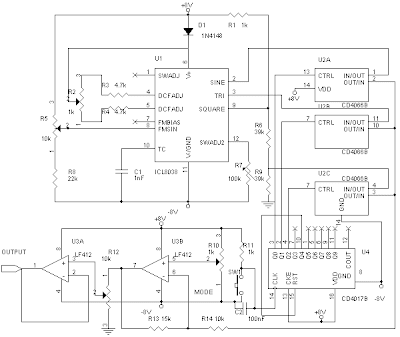TV tuner that is used on older models and new models of television there are some differences. Therefore, understanding the different types of tuner would be useful if we want to replace the tuner with the other models.
Supply voltage tuner.Tuner older models generally use a supply voltage of 12v, the new models are commonly used 5V supply voltage. Some use a 9V voltage, but very rare.
![TV]() |
| TV TUNER |
Voltage Synthesizer tuner (VS tuner)
Tuner that uses a tuning control (VT or BT) with a voltage between 0 to 33V Voltage Synthesizer tuner named. TV can be found on the aircraft models, old and new
Based on how the control band-switch, Tuner VS then there are 2 kinds, namely
Using 3-Band input sw, the VL-VH-U
Using 2-Band input sw, the Band SW1 and SW2 Band. This tuner is actually similar to the type of band 3-sw. For control-sw 2 band is in the tuner will still be converted into 3-sw bands.
Frequency Synthesizer tuner (FS tuner) or the type of PLL
Tuner wherein the tuning voltage and the voltage controlled band switching the digital communication through SDA and SCL. This tuner has a supply voltage Vcc, which is
5V is used for the digital tuner circuit control and
33V (fixed voltage or fixed) is used to control the voltage supplied to the tuning in the digital circuits within the tuner.
(Tuner old) sometimes there are additional circuit voltage of 12V to the tuner.
Frequency band.
Based on the wide range of revenue-frequency band, there are three kinds of tuner
Normal tuner
Superband tuner
Tuner hyperband
Normal tuner, the tuner that can receive broadcasts "on-air" (terrestrial) TV in the frequency band:
- Frequency of VHF Band I - VL 41-68 Mhz
- Band III - VH 174-230 Mhz
- Frequency UHF Band IV - U 470-581 Mhz
- Band V - U 582-960 Mhz
- Band II 87.5 - 104 MHz is used for FM radio broadcasting
- VL and VH bands used for broadcast channels 2 through 12
- U bands used for broadcast channels 21 to 69
Superband Tuner and Hyperband, the tuner can receive broadcast as normal tuner plus the ability to receive broadcasts "off air" CATV (cable television).
- S band using frequency band between VL and VH
- H-band using a frequency band between VH and U
- Superband Tuner can receive the broadcast band S
- Hyperband tuner can receive broadcast band and S band H
Based on the IF frequency out
IF frequency tuner out there who have 38/38.9/45.75 Mhz frequency. In Indonesia generally use 38.9Mhz frequency, but sometimes there is a use 38.0Mhz
Based on the pin-out
There are several kinds of tuner long pin-out configuration. But now almost all the tuner is already using an international standard 11-pin
Universal tuner
China is now producing "universal tuner" 11-pin. Indonesia was just the market we do not know whether it exists or not. This tuner can be used to substitute for the various types of tuners and tuner can adjust to this direct voltage of 5, 9, or 12v.
RF antenna input connector
Form the antenna input connector there are two kinds, namely:
- RCA type connectors
- Antenna RF connector
Tuner modules
Tuner is a tuner module inside there are all Video IF amplifier circuit and the FM-detector. This kind of tuner is using VS and some are using the FS.
Tuner module has output like:
- RF AGC-out
- RF AFC-out
- Audio-out
- Video-out
- Base band out, the signal to be processed into stereo sound circuit.
Except that in tuner is also sometimes diperlengkapa with audio-switch to TV / AV-in. Therefore, to the sound of the AV-in connected via Audio-in found on the tuner module. Sometimes the sound volume to be controlled in the tuner module.
- SONY tuner module 1
- SONY tuner module 2
- Toshiba tuner module
Impedance input / output
Impedance tuner has all kinds of input / output 75 ohm.
How to distinguish 2-band tuners VS sw with PLL tuner FS
In all these circumstances and the removable pin 11 feet was not cut, it is sometimes difficult to distinguish between two band-tuner tuner sw with FS.
Some models have a tuner pin legs partially emptied. FS Tuner has a location pin 30V voltage 3 numbers from the back (of the IF pin out).
 The high current capability of the LM2005 allows it to continuously endure either AC or DC short circuit of the output with a maximum supply voltage of 16V. This will protect the loudspeaker in a bridge mode, when a DC short of the output occurs on one side of the speaker.
The high current capability of the LM2005 allows it to continuously endure either AC or DC short circuit of the output with a maximum supply voltage of 16V. This will protect the loudspeaker in a bridge mode, when a DC short of the output occurs on one side of the speaker. The LM2005 is a dual high power amplifier, designed to deliver optimum performance and reliability for automotive applications. High current capability (3.5A) enables the device to deliver 10W/channel into 2X (LM2005T-S), or 20W bridged monaural (LM2005T-M) into 4X, with low distortion.
The LM2005 is a dual high power amplifier, designed to deliver optimum performance and reliability for automotive applications. High current capability (3.5A) enables the device to deliver 10W/channel into 2X (LM2005T-S), or 20W bridged monaural (LM2005T-M) into 4X, with low distortion. Features
Features












